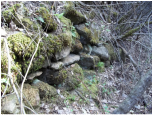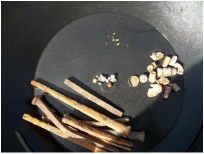

| | |
| Gold Mining Basics |
|
This weekend I went to finish the trip that Jeff and I started the previous week, which was cut short due to an injury. I picked up the trail right where Jeff was injured last week and was looking the area over trying to assess what had happened when he got injured. I was feeling quite uncomfortable in the area. I kept looking up the hill, watching for falling rocks and after a while I decided to get out of there before I drove myself crazy. Changing gears back into detecting mode, I worked my way along the hillside trying to keep approximately the same elevation. Due to the fact that I was finding no old river gravel at all, I was moving along fairly fast and haphazardly detecting as I went. All that I was finding were spent bullets every now and then. After about a quarter mile, I noticed that there were a few spots with some old river gravel. There were also a few spots that someone had dug a small hole and piled the gravel next to it. The test holes were very old and it didn't look like anyone had been there in a long time. The further north I went, the more gravel and diggings appeared. I was starting to pick up some old square nails now.  I hiked to the top of a ridge and on the other side was the main channel that the old miners had previously worked; the area was about an acre. Having never been here before, I decided to check out the entire area before I started detecting, which would allow me to start working in the most promising areas. I left my pack and detector and hiked around a bit to get a better look at the layout. I found a couple of channels where the old miners had cut through the bedrock for their sluice boxes. There were rock walls stacked up on both sides of the channels and quite a large pile of boulders behind that. They must have been finding some nice gold, because I could not find anything that was not already worked. I worked my way back to my detector, then moved to the lower end of the work area and started detecting. I decided to detect my way up the channel to the main work area. The going was tough because of the brush. It was so thick in some areas I could not swing the detector at all. The only targets I was finding were old nails, straps, bolts and trash of that sort. I did find a couple pieces of old glass, which was encouraging. I was working my way along one of the rock walls and wanted to take a look at the pile above it. As I worked my way up the wall the detector sounded off on a large target; it was registering as iron, which I decided to dig because, I did every reading when detecting for gold. After moving a few rocks I found an old, hand-forged fork that the old miners used for removing the rocks from the sluice box. It was worn but in very good shape. I continued working the area the best I could, but there were very few areas that weren't covered with tailings.  After a couple of hours I decided to go down to the river and try working any bedrock I could find. The bedrock along the river had been worked very hard; it was too close to the road. After finding a couple of split shot and a few very small pieces of gold, I decided it was time to head back towards the truck. On the way back I worked the edge of the river the best I could. I did notice that a larger gravel bar had formed just below the old work area. If the courts decide to allow dredging in California again, I may give this area a good look. I continued the search on the way back to the truck and found a few more lead targets and some more small pieces of gold. After I got back to the truck, I jotted down a few notes assessing the areas that I had just covered. This area had been worked quite a bit throughout the past. Most all the trash I had found was very old. I noticed that I had not found any trash from the 30's, and I think I know why. The entire area was worked to bedrock. I know this because of the channels that had been cut below the bedrock for the sluices. As the old miners worked their way uphill they dumped their tailings onto the lower work area and capped all of the larger rocks with mud and gravel. As I detected the area, I found several targets that were buried under two to three foot layer of dirt and gravel. Under that layer were large rocks with no gravel or dirt around them at all. The targets were usually on top of the rock or laying in the void between the rocks. I think when the miners showed up in the thirties, it was just too much work to remove the overburden to take a chance on any areas that may already have been cleaned by previous miners. The way I see it, nothing has changed. I'm not willing to remove the overburden to take a look either because there are a lot of much easier to sites to work in the area. I may go back to this spot one more time to try to locate some old bottles and do a little more checking to see if they left any of the old channel unworked. However, as of now this area has been crossed off the “gold list” and has been put on the “old bottle list”.
2 Comments
3/9/2019 01:44:55 am
There are a lot of ways in which you can assess something. First of all, you can observe an object through the use of our senses. Just looking at something gives us a lot of information about it. Secondly, conducting a research concerning the said location. There are a lot of things that you can get from the internet now, especially when it comes to dig sites like this one. Doing some research is important to secure the quality of an object.
Reply
Leave a Reply. |
AuthorGary Honan Archives
April 2021
Categories |